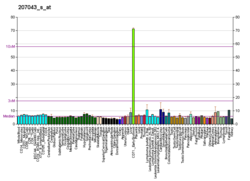Top Qs
Timeline
Chat
Perspective
Sodium- and chloride-dependent glycine transporter 1
Protein-coding gene in the species Homo sapiens From Wikipedia, the free encyclopedia
Remove ads
Sodium- and chloride-dependent glycine transporter 1, also known as glycine transporter 1, is a protein that in humans is encoded by the SLC6A9 gene which is promising therapeutic target for treatment of diabetes and obesity. [5][6][7][8]
Remove ads
Selective inhibitors
Elevation of extracellular synaptic glycine concentration by blockade of GlyT1 has been hypothesized to potentiate NMDA receptor function in vivo and to represent a rational approach for the treatment of schizophrenia and cognitive disorders. Several drug candidates have reached clinical trials.[9]
- ASP2535[10]
- Bitopertin (RG1678), which has entered phase II trials for the treatment of schizophrenia[11]
- Iclepertin (BI 425809) by Boehringer Ingelheim which is thought to improve cognitive impairment due to schizophrenia
- Org 25935 (Sch 900435)
- PF-03463275 (in phase II trial)
- Pesampator (PF-04958242) by Pfizer
- Sarcosine which is thought to improve cognitive impairment due to schizophrenia
Remove ads
Pathological mutations
Mutations of the gene may cause a severe metabolic disorder discovered in 2016 and called glycine encephalopathy with normal serum glycine (OMIM 617301), also known as GlyT1 encephalopathy.
See also
References
Further reading
Wikiwand - on
Seamless Wikipedia browsing. On steroids.
Remove ads





